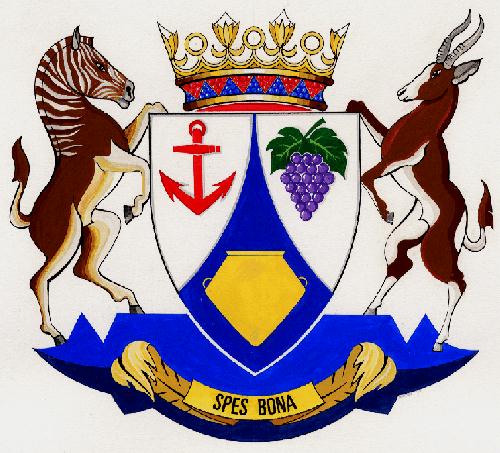Western Cape
| Heraldry of the World |
| South Africa heraldry portal Civic heraldry of South Africa |
|
WESTERN CAPE
Official blazon
(af)
- Wapen: In silwer, op 'n blou deurlopende ingeboe punt 'n goue khoi-kleipot met 'n kegelvormige basis en twee horisontaal deurboorde ore, in die skildhoof vergesel regs van 'n rooi anker en links van 'n tros druiwe gestingel en geblaar van natuurlike kleur, die skild oortop met 'n kroon bestaande uit 'n goue band tandvormig versier van rooi en blou kralewerk en verhoog van ses goue proteas, silwer geknop, en met dieselfde getal goue ringe afgewissel.
- Skildhouers: Regs 'n kwagga (Equus quagga quagga) en links 'n bontebok (Damasileus dorcas dorcas) albei van natuurlike kleur.
- Wapenspreuk: SPES BONA
(en)
- Arms: Argent, on a pale embowed inverted throughout Azure, a Khoi clay pot with a conical base and two horizontally pierced lugs, Or, between in chief dexter an anchor Gules and sinister a bunch of grapes slipped and leaved, proper; the shield ensigned of a coronet comprising a circlet, Or, embellished of beadwork indented Gules and Azure, heightened of six protea flowers, Or, seeded Argent, alternating with as many annulets, Or, proper.
- Supporters: Dexter a quagga (Equus quagga quagga) and sinister a bontebok (Damasileus dorcas dorcas) proper.
- Motto: SPES BONA
Origin/meaning
The arms were officially granted on 19 May 1998.
The idea of a coat of arms for the Western Cape originated in 1994 when the late Dr Cor Pama, a renowned heraldic expert, was requested to draft proposals. He unfortunately passed away prior to completing the project.
The designs were, however, referred to the various political parties in 1995 for discussion and presented to Mr Brownell, the State Herald, at the end of last year. He then designed the coat of arms, which has been unanimously approved by all the political parties.
The design endeavours to encapsulate the elements which enjoy the widest support, but simple enough to allow the successful reduction to the size of a postage stamp, without the loss of significant detail.
The anchor in the shield enjoys unanimous support as a symbol of hope, stability and faith amongst those who have considered the coat of arms. It also alludes to the maritime history and riches of the Western Cape.
The grapes allude to the importance of agriculture, more specifically the importance of the province as an important wine-producing area.
The clay pot in the base of the shield refers to the manufacturing sector and incorporates an artefact created by the earliest inhabitants of the province. The pot is of Khoi origin and comes from Ceres. It has a distinctive shape, having been in use in sandy conditions, and is thus an appropriate symbol.
The Quagga (Equus quagga quagga) and the Bontebok (Damaliscus dorcas dorcas) support the shield. The former, though now extinct, is now the subject of a specialised breeding programme, which hopes to produce a close replica of this animal, while the latter which was saved from the brink of extinction, is unique to the Western Cape. The two animals stand on a base in the form of a stylised Table Mountain, the Western Cape's most distinctive natural feature. Resting on the upper rim of the shield is a distinctive "coronet" comprising a beaded headring (found inter alia as a form of ornamentation among the San), heightened with alternating protea flower heads and rings.
The ribbon beneath the shield, in the form of ostrich feathers, contains the motto, Spes Bona (Good Hope), which enjoys widespread support.
Contact and Support
Partners:
Your logo here ?
Contact us
© since 1995, Heraldry of the World, Ralf Hartemink 
Index of the site
Literature : - Information and picture provided by Bruce Berry.












